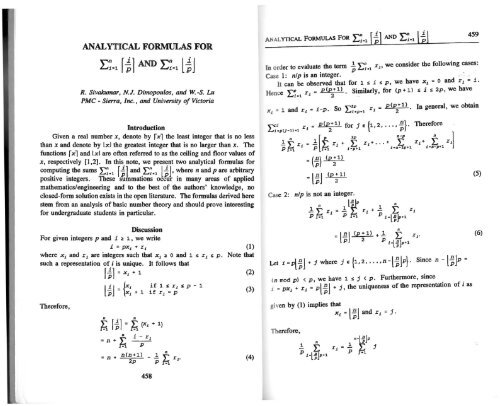Vol. 10 No 6 - Pi Mu Epsilon
Vol. 10 No 6 - Pi Mu Epsilon
Vol. 10 No 6 - Pi Mu Epsilon
- No tags were found...
Create successful ePaper yourself
Turn your PDF publications into a flip-book with our unique Google optimized e-Paper software.
ANALYTICAL FORMULAS FOR<br />
1:= 1 r !1 AND 1:= 1 l!J<br />
R. Sivakumar, N.J. Dinwpoulos, and W.-S. Lu<br />
PMC - Sierra, Inc., and University of Victoria<br />
ANALYTICAL FORMULAS FOR l:.1 [il AND l:.1 l!J<br />
459<br />
In order to evaluate the term ~ I:. 1<br />
Ii, we consider the following cases:<br />
Case 1: nip is an integer. _ - .<br />
It can be observed that for 1 ~ i ~ p, we have x 1 = o and I1 = ~.<br />
Hen<br />
ce ~"' I = P (p + 1 > • Similarly, for (p + 1) ~ i ~ 2p, we have<br />
L.Ji•1 i 2<br />
_ · so 'r'2P r = P (p +<br />
d<br />
1 > . In general, we obtain<br />
x 1<br />
= 1 an I1 - ~-p. L..,l•p+l 1 2<br />
Introduction<br />
Given a real number x, denote by r X l the least integer that is no less<br />
than x and denote by LxJ the greatest integer that is no larger than x. The<br />
functions r X l and LxJ are often referred to as the ceiling and floor values of<br />
x, respectively [1,2]. In this note, we present two analytical formulas for<br />
computing the sums I: •1 r ll and I: •1 ll j. where n and p are arbitrary<br />
positive integers. These fummations ocfur in many areas of applied<br />
mathematics/engineering and to the best of the authors' knowledge, no<br />
closed-form solution exists in the open literature. The formulas derived here<br />
stem from an analysis of basic number theory and should prove interesting<br />
for undergraduate students in particular.<br />
~J r = p(p+1) for j e {1,2, ..• ,E}· Therefore<br />
L..,jo,r;l(j-:) +1 j ( p 2 2p D~ D 1<br />
Case 2:<br />
1 r =..! Ii+ Ii+,,,+ L ri+ L ri<br />
p}.; 1 P }.; 1~1 i•n-2p+1 J.•n-p+l<br />
= (~)<br />
= l~J<br />
(p +1)<br />
2<br />
(p + 1)<br />
2<br />
(5)<br />
Discussion<br />
For given integers p and i ~ 1, we write<br />
i = px 1 + I 1<br />
where xi and I i are integers such that xi ~ o and 1 ~ I 1 ~ p.<br />
such a representation of i is unique. It follows that<br />
Therefore,<br />
fil = x 1 + 1<br />
ij {xi<br />
l if1SiiSp-1<br />
p = xi + 1<br />
~ fil =~(Xi + 1)<br />
n i- I<br />
=n+Y' ___ i<br />
!':{ p<br />
if I 1 = p<br />
= n + n(n+1) - ..! f Ii.<br />
2p p !':{<br />
(1)<br />
<strong>No</strong>te that<br />
(2)<br />
(3)<br />
(4)<br />
Let i = pl ~ J + j where j e { 1, 2 ,... , n -l ~ jP} . Since n -l ~ jP =<br />
















